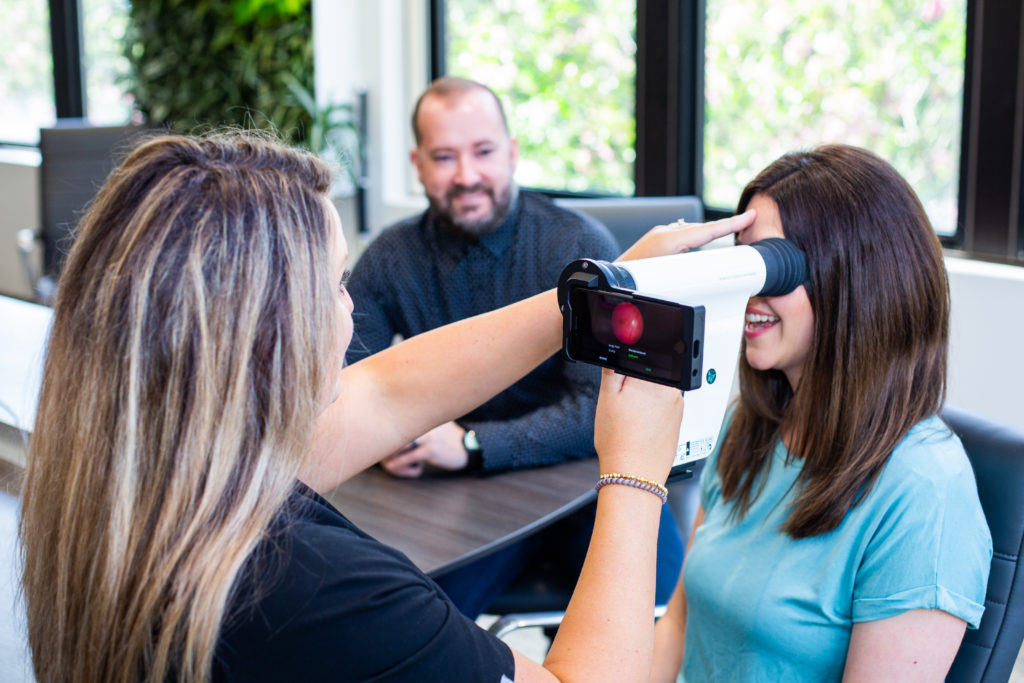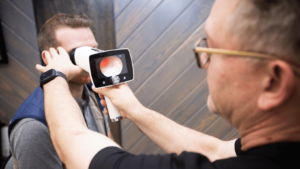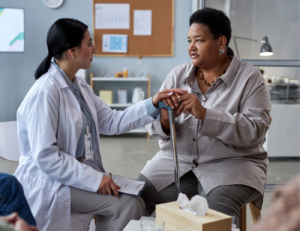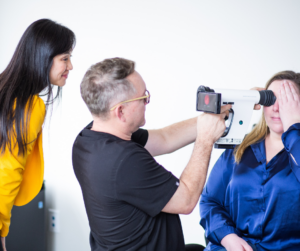Eye Care for Rural Communities

Access to routine health care is an ongoing problem for millions of Americans. In 2022, 38% of Americans reported they or a family member skipped or delayed medical care due to worries about the cost of care. Other people cite traditional barriers to medical care, including time constraints and lack of transportation to care facilities.
These concerns are exacerbated in rural communities. Rural families tend to have lower incomes than urban residents, and healthcare facilities may be a significant distance from their homes. This can result in skipping important health care screenings, including eye exams. Lack of appropriate eye care can lead to vision problems and preventable blindness.

The IRIS Solution is a flexible diabetic retinopathy screening tool that allows care providers to use a fundus camera to capture retinal images and transmit them to qualified licensed eye care professionals at the IRIS reading center. It allows primary practices, Federally Qualified Health Centers (FQHC) and Community Health Centers (CHC), hospital systems, and in-home care providers in rural areas to integrate retinal screening into their practices.
Health Care Disparities in Rural Communities
Healthcare access in rural communities is limited, and specialty care like ophthalmology may require significant travel time and high out-of-pocket costs. As a result, patients may skip essential screenings.
In 2022, over 46 million Americans lived in rural areas of the country. Rural residents make up about 15% of the overall population, but they are more likely to experience barriers to healthcare access. The lack of nearby healthcare providers and facilities is an ongoing challenge for rural communities. In addition, rural residents may face other social determinants of health that limit their access to care:
- According to the Economic Research Service data, rural residents’ average per capita income was $49,895 in 2021, compared to $64,143 for all Americans. The poverty rate in the rural U.S. is 15.4%, compared with 12.8% nationwide.
- Research indicates that economic challenges can be exacerbated by a lack of insurance coverage or being underinsured, which makes it difficult to connect with eye doctors. Getting to doctors may also be a challenge due to limited transportation. In addition, individuals in medically underserved communities may not realize eye health screenings are necessary, even for adults who don’t need vision correction.
- Many rural residents rely on FQHCs for primary and routine care. Though these centers are vital resources, they often don’t have the capacity for comprehensive eye health screenings. A 2020 study noted that FQHCs are frequently the only source of eye care available in rural areas, though in a very limited way. In 2019, HRSA reported only 444 full-time equivalent doctors of optometry and ophthalmologists across nearly 1,400 health centers. Less than 3% of health center patients received vision care services at those centers.
Other care providers, such as doctors in private practice, home health providers, and hospital systems, can conduct basic vision screenings to identify refraction errors. However, they often do not have the equipment or the training to offer comprehensive eye exams that screen for retinal disease.

The Significance of Accessible Eye Care in Rural Communities
Eye care is an essential part of overall healthcare. For people in rural areas, lack of access to care can lead to a range of eye health issues. Rural residents face higher rates of partial vision loss or low vision, preventable blindness caused by diabetic retinopathy, and refractive errors. In addition, rural residents may not receive adequate care for eye injuries or complications from eye surgery.
Routine eye care can be especially important for people over age 50 or with underlying health conditions affecting eye health. Lack of regular screening can increase the risk that conditions like glaucoma, diabetic retinopathy, or macular degeneration go undiagnosed. Without early detection and prompt treatment, these conditions can lead to irreversible vision loss or blindness.
Diabetes, in particular, has significant risks to eye health. Poorly managed blood sugar increases the risk of diabetic retinopathy.
There is also a correlation between certain diabetes medications and risks to eye health. Studies have revealed a link between Ozempic and decreased eye health, including:
- Enhanced risk of macular degeneration
- Blurred vision
- Increased symptoms of diabetic retinopathy
The American Academy of Ophthalmology suggests increasing the availability of in-person eye care is one solution to the rural eye health crisis. In the same publication, the AAO praises the efficacy of teleophthalmology solutions as a tool to overcome rural healthcare challenges and increase access to diabetic retinopathy screenings.
Retinal Screenings in Rural Communities
Diabetic retinopathy screenings are a vital part of annual care for patients with type one or type two diabetes. The CDC estimates that diabetes is more common in rural areas, affecting nearly 10% of rural adults. Every person with diabetes is at risk of developing diabetic retinopathy, which can cause vision loss or blindness without treatment.

Diabetes poses several risks to eye health and vision, including:
- Diabetic retinopathy: Diabetic retinopathy is the leading cause of blindness in American adults. It is one of the main reasons annual retinal screenings are so crucial to preventing blindness.
- Increased risk of cataracts: Cataracts can form earlier and progress faster in people with diabetes.
- Glaucoma: Neovascular glaucoma is a complication of diabetic retinopathy. The damage from DR increases pressure in the eye, which can damage the optic nerve and cause glaucoma.
- Macular Edema: Macular edema is closely related to diabetic retinopathy. Excess fluid in the eye causes the macula to swell and thicken, distorting vision.
These conditions are all asymptomatic in the early stages, though they can be diagnosed during a dilated eye exam or similar screening. Early diagnosis allows patients to begin treatment for serious eye conditions before they suffer vision changes or vision loss.
Enhancing Rural Eye Care with IRIS & IRIS Now
The IRIS platform broadens access to retinal imaging screenings by putting the screening tools in the hands of primary care providers, in-home health services, FQHCs and CHCs, and hospital systems. The goal is to make retinal screenings available to patients in primary care, clinic, or in-home settings instead of requiring them to travel to an ophthalmologist at an additional cost of their time and money. With IRIS, retinal screenings can become a routine part of care visits.

Providers can deploy the IRIS solution in any setting using a fundus camera to perform retinal screenings. IRIS is compatible with both stationary and mobile fundus cameras. Practitioners or other trained technicians can capture diagnostic images, which they then upload to the secure, cloud-based IRIS platform.
Licensed eye care providers from the IRIS Reading Center (IRC) review patient images and results are returned to the ordering provider, with recommendations for follow-up care and treatment as needed.
IRIS’s newest service, IRIS Now, is optimized to let smaller practices integrate the IRIS solution into their practices. It streamlines the onboarding and training process so that medical teams can begin using IRIS quickly.
Client Success Story
Dr. Kim Perry worked in community hospitals in underserved areas. She routinely referred patients for needed diabetic retinopathy screenings, but communication gaps between her facility and the nearby ophthalmology practices led to delays in getting test results.
She learned about the IRIS solution while working for United Health and immediately saw how it could help small practices and community health facilities. She observed practices that invested in a handheld fundus camera and the IRIS solution improved their HEDIS compliance measures. More importantly, there was clear evidence that the number of patients receiving their annual diabetic retinopathy eye exam increased.
When Dr. Perry opened her own small practice, she offered IRIS screenings to her patients. Overall, the screening added only a few minutes to routine appointments and dramatically increased patient adherence to vision screening guidelines.
Increasing access to retinal screening can improve eye health for rural populations. Giving primary care providers, in-home care providers, and healthcare facilities in rural communities tools like IRIS and IRIS Now enables them to perform retinal screenings and brings important eye care to rural residents.
To learn more about how IRIS and IRIS Now can improve eye health outcomes for rural patients, contact us for a free demo.
FAQs
Who provides rural eye care?
Primary care doctors, local hospital systems, and community health centers provide FQHC optometry services for eye care.
What services are typically offered in rural eye care clinics?
Many rural eye care providers offer routine eye care, including basic vision and non-diagnostic disease screenings. These clinics may also provide acute care for patients with eye injuries, infections, and sudden vision loss. Some eye care facilities offer preventative eye care, but that is less common.
Why is rural eye care important?
Lack of access to comprehensive eye care is one part of a larger trend in rural healthcare access. Rural communities are often medically underserved, particularly for specialist care. Without access to comprehensive eye care, rural residents are at risk for vision-threatening conditions. Increasing access to diagnostic and preventative eye care can reduce the risk of preventable vision loss.
What are some common eye health concerns in rural areas?
Residents in rural areas may face limited access to care clinics, clinics that offer limited services, and a lack of education surrounding eye health.
Are there any financial assistance programs available for rural eye care?
CHC and FQHC optometry services provide federally-funded eye care in rural areas at no or reduced cost to patients.
Get started with IRIS today.
Want to know if IRIS is right for you? Schedule a one-on-one consultation with our team. We’re here to help.